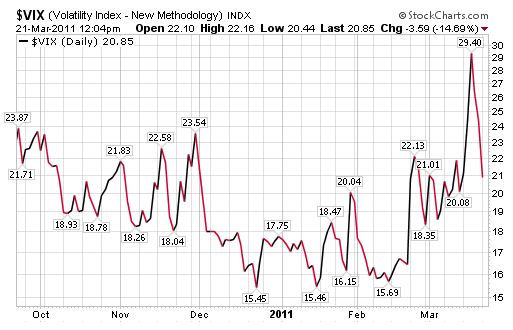VIX is the ticker symbol for the Chicago Board Options Exchange Market Volatility Index, a popular measure of the implied volatility of S&P 500 index options. Often referred to as the fear index or the fear gauge, it represents one measure of the market's expectation of stock market volatility over the next 30 day period. The VIX Index was introduced by Prof. Robert Whaley in 1993 while he was at Duke University.
Russell Note -- implied volatility is the amount of change that option traders foresee during the 30-day period ahead. When traders become fearful, they foresee volatility rising, which is why, when the VIX rises, it's generally considered an indication of a falling market ahead. Falling markets are usually associated with rising volatility.
The chart below follows the VIX back to 2001. From 2003 to 2007 the VIX headed down as volatility turned lower. Starting in 2007, option traders foresaw volatility heading higher, and by the peak in 2009 the VIX had rocketed to a high of almost 80 as the vicious bear market set in.
From there, the VIX declined to a low in late-2010, only to be followed by a sharp rise to 40 in March of 2010. The VIX then sank to a low of just above 15 during February-March of 2010. The latest move of the VIX was a rise to 31 in March (this month), and then a decline down to 20.
The latest VIX action shows the VIX surging to 29 during this month of March, then most recently sinking down to 21 again. This suggests a nervous market, but based on up-to-the-minute reading, option traders don't see trouble ahead with the VIX back at the 20.12 level.
Meanwhile, my eyes are fastened on the US Dollar Index. The Index is down around the critical 50 level, and as this occurs -- gold rises.
As I write April gold is selling at 1432.50, only 5 points from its record high of 1437.
If the dollar continues to slide, its status as the world's reserve currency will run into trouble. If the US dollar loses its "crown" as the world's reserve currency, it's a game-changer and a new ball game.
To access the full report or subscribe to Richard Russell’s Dow Theory Letters CLICK HERE.








